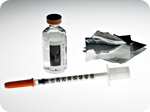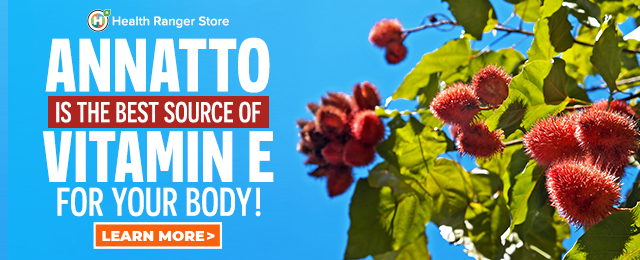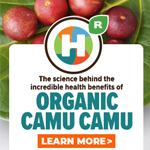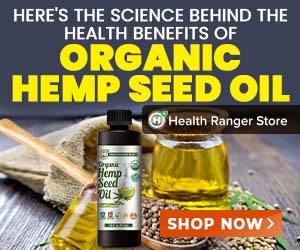
Inulin: Friend or Foe?
Monday, December 10, 2007 by: Patty Donovan
Tags: inulin, food ingredients, health news
- Brushing with poison: Study finds toxic heavy metals in 90% of toothpaste brands, including those for children
- The truth about Benzyl Alcohol in beauty products
- X-class solar flare sparks worldwide disruptions, with more storms expected as sunspot turns toward Earth
- Hidden poison in your medicine and supplements: How phthalates in capsules are silently attacking your heart, thyroid, and hormones
- DOJ targets controversial “Proximal Origin” study in push for scientific transparency
- HHS launches Generation Gold Standard, ushering in UNIVERSAL FLU VACCINE spearheaded by Bill Gates
- China's sodium battery revolution sparks global EV rivalries and resets market rules
- Australia’s vaccine cover-up: 35 died same day as COVID shot, but authorities ignored them
- Gaddafi's prophecy unfolds: How NATO's destruction of Libya fueled Europe's migration crisis
- EU court exposes secret Pfizer deal, orders von der Leyen and Bourla to reveal concealed texts
- Breakthrough study links mRNA vaccines to irreversible female fertility loss
- OUTRAGE: Georgia shields pesticide giants from cancer lawsuits as corporate lobbying silences victims
- FDA cracks down on unapproved fluoride drugs for kids as science exposes decades of deception
- Renegade cardiologist joins MAHA, demands immediate halt to mRNA vaccines and overhaul of US health policies
- Canada's COVID cover-up: Health officials swore secrecy to protect Trudeau from vaccine scandal
- Sitting too much? New study reveals even exercise can't fully offset brain shrinkage risk
- Lard: A highly nutritious but misunderstood superfood
- Big Pharma's Dirty Secret: How Prescription Drugs Are Starving Your Body of Essential Nutrients
- Singapore's draconian vaccine mandate: Citizens face jail time for refusing FORCED medical procedures that do HARM
- WAR ON COGNITION: The Coordinated Assault on Your Brain and How to Defend Yourself Against Every Attack
- Big Pharma's Dirty Secret: How Prescription Drugs Are Starving Your Body of Essential Nutrients
- JESUS NEVER SPOKE ENGLISH: Historical facts on why the Bible you’re probably reading has been altered, redacted or hidden from much of its original meaning
- Canada's COVID cover-up: Health officials swore secrecy to protect Trudeau from vaccine scandal
- RED ALERT: Nuclear War Between India and Pakistan Could Trigger Global Catastrophe… full RISK ANALYSIS
- Gene-edited pork sneaks onto your plate: FDA quietly approves CRISPR pigs amid health and ethical concerns
- Silent catastrophe: COVID-19 vaccines linked to plummeting fertility rates, Czech data reveals
- Nicole Shanahan exposes RFK Jr.'s 'Broken Promise' - Claims Surgeon General Pick Casey Means is a 'Manchurian Asset' in shocking allegation
- EU embraces censorship over solutions as energy grid crises spark blackout fears
- Why All Government Officials and Big Tech CEOs Who Engage in Systematic Viewpoint Censorship Must Be ARRESTED, Prosecuted, and Sentenced to Life in Prison
- Texas governor threatens San Marcos over pro-ceasefire resolution, igniting free speech debate
- Polar ice rebounds confound alarmist predictions: New studies highlight climate's unpredictable dance
- Survival basics: 5 Dangerous locations to avoid during an EMP attack
- Health Ranger Report: Christopher Bjerknes challenges conventional narratives about world history
- Landmark study of 85 million reveals shocking surge in heart attacks, strokes, and sudden death following the notorious COVID-19 jab
- Spike protein found in stroke victims’ brains up to 17 months after injection, study reveals
- Virologist who endorsed HCQ for COVID-19 appointed to top pandemic post at HHS
- The Miraculous Healing Power of DMSO: Nature's Forgotten Cure for Cancer, Pain, and Regeneration
- Biblical truth: God will carry out a “cosmic reset” of Earth and destroy all human civilization with a series of extinction-level cosmic impacts known as The Seven Trumpets, Seven Bowls and Seven Seals
- URGENT REPORT: The China Import Embargo - What to Stockpile Now Before America Runs Out
- The Ultimate Survival Guide to Baking Soda: A Miraculous, Multi-Purpose Remedy for Health, Home, and Emergency Preparedness
- Widespread social and economic unrest: Steve Quayle issues urgent financial warning of imminent asset collapse in new interview with Mike Adams
- Aerosolized bioweapons? Strange “diploid biomasses” falling out of the sky in Florida captured under the microscope
- A call to preserve America’s future: “Defeating Big Government Socialism” by Newt Gingrich
- Stunning Visualization of the Seven Trumpets in the Book of Revelation
- Big Pharma launches “Vaccine Integrity Project” to combat Secretary Kennedy and keep 94 shots going into kids with mandates and liability protections
- World Economic Forum's current downfall exposes legacy of totalitarianism, financial fraud, and crimes against humanity
- Biden regime deployed over 600 grants to fund disinformation agenda, to silence the truth and stifle debate
- The Miraculous Healing Power of Green Tea: Unlocking the Potent Antioxidants That Big Pharma Doesn't Want You to Know About
- Russia escalates censorship war, targets over 200 VPN apps amid Google resistance
- Kiss Your Genetic Privacy Good-Bye! 23andMe Gets Green Light to Sell Your Intimate Genetic Details to Anyone They Want
- The unspoken truth about chemotherapy: These “treatments” create toxic time bombs in your body called CELL-KILLING PARTICLES
- A win for free speech: State Department SHUTS DOWN controversial disinformation office
- U.S. Government's Bio-War Against America: 15 Historical Medical Horrors Inflicted on the American People by the Government Itself
- U.S. demands U.K. protect FREE SPEECH, repeal hate speech authoritarianism, in latest trade deal negotiations
- Red Cross issues warning to stop blood plasma donations from vaccinated people
- Scientists confirm: GENIUS brain function can be spontaneously unleashed in humans without any apparent cause
- EPA advisor admits the agency is funneling billions to climate groups ahead of Trump’s return to White House
- HYSSOP: What research reveals about the health benefits of this ancient holy herb
- Two containers with completed ballots fall out of truck in Florida
- Newly released JFK files reveal Pentagon's role in creating Lyme disease and covid in the same lab
- Mike Adams releases country western hit single: Goin’ Back in Time is Comin’ Home
- Global leaders unite to clamp down on “misinformation” with UN-backed Cascais Declaration
- BREAKING: 2025 NDAA authorizes mandatory military draft of WOMEN across America… as Pentagon pursues global NUCLEAR war with both Russia and China at the same time
- I Want My Bailout Money – new song released by Mike Adams
- Michael Yon warns of a ZIONIST TAKEOVER in Trump’s second administration
- The Health Ranger releases “Vaccine Zombie” song and music video, using AI-animated zombies for the music video
- Ozempic and Wegovy weight loss drugs are injectable LIZARD VENOM PEPTIDES that may unleash a devastating wave of organ failure… side effects align with symptoms of SNAKE BITES
- BOMBSHELL: DNA testing kits are a SCAM to develop ethnic-specific bioweapons
- These 13 countries just signed an agreement to engineer a global FAMINE by destroying food supply
- Israeli soldiers accused of even more torture and abuse in the West Bank
- RFK Jr. clears key hurdle: Sen. Susan Collins backs controversial HHS nominee, signaling a new era for health policy
- Sermon 30: How Jesus reveals Caesar’s FAKE CURRENCY and FALSE AUTHORITY
First of all, what is inulin? Inulin is a carbohydrate belonging to a class of compounds known as fructans and is closely related to fructo-oligosaccharides (FOS). Although they aren’t the same, you will often find them used interchangeably. These are all starches (carbohydrates), just varying in structure. Since inulin is not absorbed from the gastrointestinal tract, it is considered to be a fiber. It is a soluble fiber as opposed to cellulose which is insoluble. Inulin/FOS also goes by names such as Neosugar, Alant Starch, Atlanta Starch, Alantin, Dahlin, Helenin, and Diabetic Sugar. It also has a slightly sweet taste and is very low on the glycemic index making it suitable for diabetics. There are even some claims it can be used as a sugar substitute.
It is found naturally mostly in root vegetables. Tiny amounts are found in onions and garlic, while much larger amounts are found in starchy roots such as chicory root and Jerusalem artichokes (sun chokes), although inulin content in these vegetables can vary according to season and harvest time. Storage also affects the differing carbohydrate levels – sometimes they are high in inulin and sometimes they don’t contain any. Because inulin isn't digested in the upper gastrointestinal tract, it reaches the large intestine intact where it is fermented by your native bacteria. Currently, inulin is promoted primarily as a pre-biotic and as a fiber supplement. Prebiotics are defined as: Non-digestible food ingredients that beneficially affect the host by selectively stimulating the growth and/or activity of one or a limited number of bacteria in the colon, and thus improve host health.
The good properties of inulin:
Inulin is being touted as a pre-biotic and showing up in all kinds of foods, especially in dairy. Because it transits to the large intestine almost unchanged, inulin essentially serves as fertilizer for the bacteria in your colon. Certain lactobacillus species of bacteria have been shown to preferentially ferment inulin/FOS, especially the Bifidus species. For this reason, it is being promoted as a supplement to feed the good bacteria in our guts. Bifidobacteria digest inulin to produce short chain fatty-acids, such as acetic, propionic, and butyric acids. The first two fatty acids can be used by the liver for energy production, while butyric acid has been shown to have cancer-preventing properties within the intestine. Recent animal research also shows that inulin prevents precancerous changes in the colon.
The feeding of inulin/FOS to human volunteers alters the gut flora composition in favor of one of the good guys, bifidobacteria. More studies in people need to be done to determine the value of prebiotics. It may be possible to prevent various gastrointestinal complaints through the selectively targeting specific gut bacteria. Other studies indicate that lactobacillus, bifidobacteria and other non-pathogenic bacteria create environments in which pathogenic bacteria are inhibited by modifying pH, producing surfactants that keep pathogens from binding to the lining of the gut and making compounds that are toxic to the undesired bacteria.
Another very interesting study that shows a benefit of ingesting inulin was done by Institute of Human Nutrition and Food Science, at the University of Kiel, Germany. In hamsters, inulin was able to lower VLDL, but not LDL and HDL, although the mechanism of action wasn’t fully understood. Other studies show that nondigestible oligosaccharides can increase the absorption of several minerals (calcium, magnesium, in some cases phosphorus) and trace elements (mainly copper, iron, zinc).
Ok, at this point you may be thinking great . . . what’s the problem?
The bad properties of inulin:
Manufacturers claim that inulin/FOS specifically feeds only good bacteria. Unfortunately, this isn't reality. A good example is Klebsiella. Recent studies have shown that inulin/FOS encourages the growth of Klebsiella, a bacteria implicated in Ankylosing Spondylitis and in increased intestinal permeability (leaky gut). Although present in the colon of most people, it is held in check by beneficial bacteria and is harmless WITHIN the colon. Once it gets to other areas of the body, Klebsiella becomes a major cause of infection (and sometimes death), causing serious infections in the urinary tract, pneumonia and in wounds. Inulin/FOS may indeed promote the growth of lactobacillus bacteria, but what other potentially harmful bacteria are being fed at the same time? Furthermore, many different species of yeast are able to utilize inulin/FOS for energy including Candida Albicans.
These same manufacturers also claim that because inulin is found naturally it must be fine. Here’s a good example of why this reasoning is flawed. Sucrose (table sugar) is naturally found in beets, sugar cane, oranges, and other plants. Humans removed this naturally occurring substance from a whole food source and refined it into a chemical. Sucrose is probably one of the most unhealthy food additives in human history. Another example, even worse than sucrose, is the refining of corn into High Fructose Corn Syrup which is now known to cause heart disease among many other problems. We should learn from our experiences with these and apply them to inulin/FOS. Instead of adding refined, super concentrated inulin/FOS to your food, eat the foods that naturally contain inulin/FOS.
The body is genetically adapted to certain foods and as we continue to mess with our food chain, our health suffers the consequences. Of the nutritional fibers, cellulose was the most likely to be included in a traditional hunter-gatherer diet. Cellulose is an insoluble fiber that is slowly fermented by the microbial population in the human colon. Inulin/FOS is a soluble fiber that is quickly and easily fermented. "The difference between cellulose (a food we are adapted to) and inulin/FOS (a food we are not adapted to in large quantities) is like the difference between a slow burning ember and a raging fire. Who likes playing with fire?" (http://www.healingcrow.com/ferfun/conspiracy/conspiracy.html) .
There has been one documented case of anaphylactic reaction to inulin. As it permeates the food supply, there will likely be more and more reports of allergy and/or intolerance to inulin/FOS. Symptoms of intolerance usually include flatulence, bloating, cramps, abdominal pain, diarrhea and rarely, constipation. Basically, the worse the natural population of bacteria and yeasts in your colon, the worse the symptoms of intolerance. Some studies in people not known to regularly ingest inulin have shown that people’s reactions vary greatly. It has been determined that people fall into one of three categories regarding sensitivity to inulin: 1) nonsensitive persons can consume 30 g/d (grams per day) or more of the compound with little or no symptoms as described 2) sensitive persons can consume 10 g/d of the compound without discomfort but might experience undesirable reactions with doses of 20 g/d; 3) very sensitive persons can experience symptoms of intolerance at doses as small as of 10 g/d. Unfortunately, these studies did not include analysis of the flora initially present in the colon.
Undoubtedly, inulin and FOS have many beneficial actions. The disadvantage seems to be in taking inulin/FOS when the colon is filled with “bad” bacteria and yeast (dysbiosis) because then it may cause major problems. This may be helped by taking a probiotic along with inulin/FOS. Another very strong caveat is past history with taking a single ingredient out of a whole food and refining it. Over and over this has been shown to be deleterious to our health. At this time, I think the verdict is still out on these substances. If you think inulin may be helpful to you, ingest it in the form of a whole food; by eating chicory root, Jerusalem artichokes or other foods naturally high in this substance. All ingredients present in whole foods work harmoniously with each other. Just as refining a single ingredient in an herb and calling it “medicine” often results in a deadly poison, so too does refining a single ingredient out of whole food often turns that ingredient into a toxic substance.
Sources:
http://www.raysahelian.com/inulin.html
http://www.healingcrow.com/ferfun/conspiracy/conspiracy.html
http://jn.nutrition.org/cgi/content/full/129/7/1412S
http://jn.nutrition.org/cgi/content/abstract/128/11/1937
http://jn.nutrition.org/cgi/content/abstract/137/11/2513S
Reddy BS, Hamid R, Rao CV Effect of dietary oligofructose and inulin on colonic preneoplastic aberrant crypt foci inhibition. Carcinogenesis 1997 Jul;18(7):1371-1374
Dietary modulation of the human gut microflora using the prebiotics oligofructose and inulin.
J Nutr 1999 Jul;129(7 Suppl):1438S-41S
About the author
Patty Donovan was in a wheelchair and could only walk around her house with a cane. She was on over 20 medications. When told to "take the morphine, get in the wheelchair and learn to live with it" by a neurosurgeon, she knew her life had to change. She is now almost a fanatic when it comes to healing through the use of "whole foods" and and natural remedies. Since that time, she has spent countless hours researching nutrtion and alternative health. After spending 30 years in the allopathic health care industry in both pharmacy and as an RN, she brings a unique perspective to Natural News readers. Since committing to this new life style, she no longer uses even a cane, has gotten off over 20 medications, lost over 50lbs and returned to work.Inulin at FETCH.news
Get independent news alerts on natural cures, food lab tests, cannabis medicine, science, robotics, drones, privacy and more.
Take Action: Support Natural News by linking to this article from your website
Permalink to this article:
Embed article link: (copy HTML code below):
Reprinting this article:
Non-commercial use OK, cite NaturalNews.com with clickable link.
Follow Natural News on Facebook, Twitter, Google Plus, and Pinterest
Science News & Studies
Medicine News and Information
Food News & Studies
Health News & Studies
Herbs News & Information
Pollution News & Studies
Cancer News & Studies
Climate News & Studies
Survival News & Information
Gear News & Information
News covering technology, stocks, hackers, and more



"Big Tech and mainstream media are constantly trying to silence the independent voices that dare to bring you the truth about toxic food ingredients, dangerous medications and the failed, fraudulent science of the profit-driven medical establishment.
Email is one of the best ways to make sure you stay informed, without the censorship of the tech giants (Google, Apple, Facebook, Twitter, YouTube, etc.). Stay informed and you'll even likely learn information that may help save your own life."
–The Health Ranger, Mike Adams












































